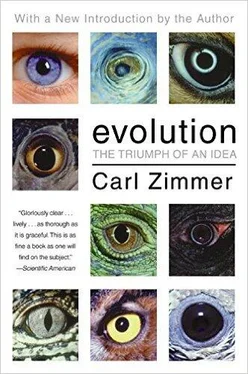Evolution on Double Time
It may not have taken very long for life to evolve from the earliest organisms, with just a handful of genes, to full-blown microbes such as cyanobacteria, which contain more than 3,000 genes. Scientists still have few clues to this chronology, but what they do know suggests that early evolution ran at a brisk pace. Fossils from Australia, for example, show that there were definitely cyanobacteria-like microbes on Earth 3.5 billion years ago. Molecular fossils from Greenland tell us that some kind of life was on Earth 350 million years earlier, by 3.85 billion years ago. Scientists can’t say exactly what sort of life was leaving its mark in Greenland, but it was already altering the chemistry of the oceans and atmosphere on a global scale. Perhaps it was cyanobacteria-like microbes, or perhaps only RNA-based organisms, or perhaps something in between.
Now compare what we know about life’s history to what we know about Earth’s history. Earth is 4.55 billion years old, and for the first few hundred million years, enormous impacts regularly melted the planet all the way through. Any life that had formed during this violent time might have been eradicated. Even after Earth had reached its current size and oceans had begun to form, million-ton rocks continued to fall out of the sky every few million years. If life existed on Earth when these impacts occurred, it might have survived in hidden refuges, perhaps in the chambers of undersea volcanoes. But it might also have become extinct. The last storm of titanic impacts occurred 3.9 billion years ago; 50 million years later, life was well established, and 350 million years later sophisticated microbes were definitely alive.
How could such a complex genetic system have evolved so quickly? The biologists who forged the modern synthesis of evolution mainly studied how minor genetic changes—a switch of A to G at one position in a gene, for instance—could add up to big evolutionary results. But it turns out that there’s another important ingredient to evolution: the accidental duplication of entire genes.
Gene duplications occur at about the same rate as single-base mutations. Once a new copy of a gene appears, it may end up with one of several fates. It may make more of the protein the original gene made, which may raise the organism’s fitness. The protein may be essential for processing food, for example, and making more copies of the protein lets an organism eat more efficiently. In that case, natural selection will hold on to the duplicated gene in a form much like the original.
But the extra gene may instead be superfluous. In these cases, a mutation that strikes the new copy won’t affect the fitness of the organism that carries it, because the original gene is still doing its job. Most of the time a mutation to a duplicated gene will simply render it useless. Our DNA brims with these genetic ghosts, known as pseudogenes. But sometimes mutations can transform a duplicated gene so that it makes new proteins that can do new jobs.
The genomes of bacteria, archaea, and eukaryotes all contain hundreds of duplicated genes, which can be grouped into families in much the way species are grouped together. And in both cases, the grouping reflects a common descent. Gene families are the work of many rounds of gene duplication, reaching back to the earliest stages of life. Genes did not simply mutate on the early Earth: they multiplied.
Fusion Evolution
Even after the tree of life had split into its three main trunks, evolution was still able to fuse together its distant branches. We should be grateful that it could, because we are a product of one of these unions; other fusions gave rise to plants and algae. If life hadn’t combined in these ways, there’d be little oxygen on Earth for us to breathe, nor would we be able to breathe what little oxygen there was.
Our respiration depends on sausage-shaped blobs in our cells called mitochondria. Almost all eukaryotes have mitochondria, which use oxygen and other chemicals to create fuel for our cells. When mitochondria were first discovered at the end of the 1800s, many scientists were struck by how much they looked like bacteria. Some even went so far as to say that they were bacteria—that somehow every cell in our body was invaded by oxygen-breathing microbes, providing them shelter in exchange for fuel.
Scientists already knew that other bacteria could live inside animals or plants and not cause disease. In many cases they actually had a mutually beneficial existence, known as symbiosis. Some bacteria live inside cows, for example, and digest the tough tissues of the grass their hosts eat; the cows then eat some of the bacteria. Still, it was one thing to say that bacteria lived inside our bodies, and another to say that they lived inside our cells. Many scientists remained skeptical.
But meanwhile more bacteria-like things were turning up inside cells. Plants, for example, have a second set of blobs in their cells that they use to carry out photosynthesis. Known as chloroplasts, they capture incoming sunlight and use its energy to combine water and carbon dioxide into organic matter. And like mitochondria, chloroplasts bear a striking resemblance to bacteria. Some scientists became convinced that chloroplasts were, like mitochondria, a form of symbiotic bacteria—specifically, that they descended from cyanobacteria, the light-harnessing microbes that live in oceans and freshwater.
Until the early 1960s, the symbiotic theory sputtered in and out of scientific fashion like a weak flame. Most scientists were so focused on discovering how DNA in the nucleus of our cells stored genetic information that the symbiotic theory, claiming that our cells were made up of more than one organism, sounded absurd. But in the 1960s, scientists discovered that mitochondria and chloroplasts have genes of their own. They use their DNA to make their own proteins, and when they duplicate themselves, they make extra copies of their DNA, just as bacteria do.
Yet in the 1960s scientists still lacked the tools for finding out exactly what sort of DNA mitochondria and chloroplasts carried. Perhaps, some skeptics argued, their genes had originated inside the nucleus, and at some point evolution had moved it into outlying shelters. Then in the mid-1970s two teams of microbiologists, one headed by Carl Woese and the other by W. Ford Doolittle at Dalhousie University in Nova Scotia, showed that this was not so. They studied the genes inside the chloroplasts of some species of algae, and they found that they bore little resemblance to the genes in the algae’s nucleus. Chloroplast DNA, it turns out, is cyanobacteria DNA.
The genes of mitochondria had an even more astonishing story to tell. In the late 1970S Doolittle’s team showed that they were also bacterial genes, and in the years that followed, other scientists zeroed in on exactly which kind of bacteria they belonged to. In 1998 Siv Andersson of Upsalla University in Sweden and her colleagues discovered the closest relative of mitochondria yet known: Rickettsia prowazekii, a vicious bacteria that causes typhus.
Rickettsia is carried by lice and normally makes rats its home, but the parasite can also live in humans. And when humans live in filthy, cramped conditions where lice and rats can thrive—such as slums and army camps—a typhus epidemic can break out. Once the bacteria enter a person’s body through the bite of a louse, they push their way into the cells of their host, feeding on them and making more copies of themselves. A raging fever and unbearable aches follow, and sometimes even death.
Typhus is a disease so lethal that it can steer the course of history. When Napoleon set out to defeat Russia, he marshaled an army of half a million soldiers. In 1812 they marched east across Poland. The Russian army retreated from them, never engaging in battle, and when Napoleon arrived in Lithuania, he took the capital, Vilnius, without firing a shot. Yet by the time his army entered the city, 60,000 French soldiers were already dead of typhus.
Читать дальше












